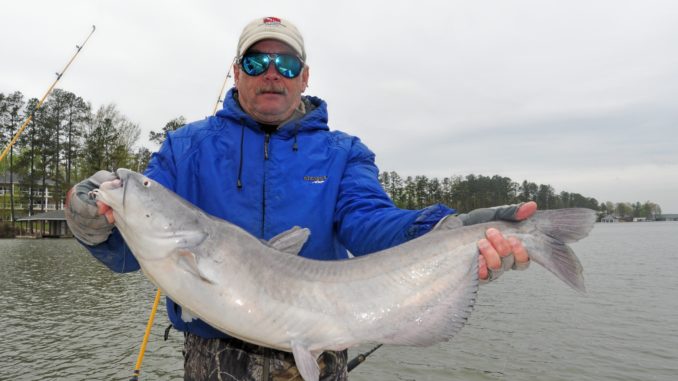
Slow-troll live or cut baits for a cooler full of Lake Gaston blue catfish.
If you want the best-tastin’ catfish in the United States, try spiced, deep-fried chunks when you find yourself in Louisiana or walking through the doors of a restaurant that specializes in genuine Cajun soul food.
Down in the bayous, they even serve up what they call a “catfish Po-Boy dressed” — a submarine sandwich with two or three fried catfish filets between two long slices of French bread and shredded lettuce, tomato slices, dill pickle slices, Creole mustard, ketchup, cocktail or tartar sauce, sea salt and Creole seasoning.
So it’s entirely understandable that Don Enderle, a Louisiana native, would be one of the top catfish guides on Lake Gaston. He knows how to catch these broad-shouldered beasts, some of the “blue” variety that have pegged at 60 pounds or more on the certified digital scales he keeps in his boat’s console.
Enderle’s family moved from New Orleans to Raleigh in 1963 when he was five. Even with that early displacement, fishing urges and abilities that were obviously in the family’s gene pool and settled in him at an early age.
Now 56, Enderle started guiding during the 1980s, the heyday of Gaston and nearby John H. Kerr Reservoir as largemouth and striped bass destinations. An engineer for a construction company who lives in Rocky Mount, he enjoys guiding on Kerr, Gaston and Roanoke Rapids lakes.
“Things like water conditions and the bite are always changing from one lake to another,” he said. “In summer, I can troll for striped bass at Kerr and Gaston; in spring I can go to the tailraces at Kerr and Gaston dams and get into spawning runs of stripers and sometimes walleye. Spring and early summer are good times at Roanoke Rapids Lake for stripers, and you can fish the Roanoke Rapids grass for largemouth bass. Catfishing can be awesome at Kerr and Gaston in the summer.”
Lake Gaston is 35 miles long and spreads across 20,000 surface water acres, but it’s almost a riverine system, with current flowing west to east. Famous for its stump fields and docks that attract largemouth bass and anglers each spring, Gaston also has held blue, flathead, channel and bullhead catfishes for years.
“The best place for flatheads is up the river toward the I-85 bridge,” said Enderle, who knows several holes that contain blowdowns and rocks that are among the best spots on the lake to catch flatheads.
“You just downsize your tackle if you want to catch channel cats, which a lot of people do because they’re good to eat,” said Enderle, who said channel cats at Gaston average between five and 10 pounds.
But blue cats are the largest, most-active predatory fish that swims in Lake Gaston.
“The food chain for bigger fish up here probably has blue catfish at the top, followed by stripers, then largemouth bass, then walleyes,” he said. “There might be more monster blue cats at Buggs Island (Kerr Lake), but I’ve caught 60-plus pounders from this lake, and there’s been 80- and 84-pounders caught here. But a normal Gaston trophy blue will weigh 30 to 50 pounds.”
As Enderle sees it, blue cats have an advantage over flatheads, which also may grow to prodigious sizes.
“Blue cats will eat live or dead baits,” he said. “Flatheads mostly like live bait, mainly live bream.”
Over the years, Enderle has learned the easiest and quickest-to-reach baitfish spots at the lake, so finding bait often takes about 30 minutes, although it can take longer.
“I don’t feel good unless I have at least 50 live shad swimming in my bait tank,” he said. “I like to double-bait hooks some times, so if you got a dozen rods out and are slow-trolling, it doesn’t take long to go through a lot of bait.”
His aerated bait tank is in the front of his center-console boat, but when targeting catfish, he uses a bow-mounted trolling motor with a remote-control device resembling a wrist watch that controls his speed and direction, leaving him free to tend his rods.
At Gaston, where the water level cannot rise or drop more than 18 inches by law, Enderle does most of his fishing in tributary creeks or in the narrow, upper reaches of the river.
“If the bite’s going good, sometimes I’ll stay in the same creek all day,” he said.
Enderle uses the slow-trolling approach to present his baits to catfish. Besides six rods in rod holders that pull traditional Santee rigs — with 1-ounce “string” weights or circular 1-ounce river sinkers and which he calls “down” lines — he likes a long leader with a bream cork tied to a 3-way swivel to keep his baits from hanging up on rocks and wood. He also deploys four rods on the gunwales — two on each side — attached to planers so he can cover a wider swath of water and that pull baits that are supposed to skim just above the bottom.
He also ties slip knots on his free lines that stop a barrel-shaped cork from sliding up the line. The weights and hooks on free lines can be held at a specified depth by the cork; the rig allows him to troll baitfish at different depths.
“I fish in shallow water a lot,” he said. “In fact, I prefer it shallow. Catfish aren’t always in deep water; they’re usually just close to the bottom.
“In May, baitfish will get in creeks that might only be six to 12 feet deep, and blues cats, which are all over the lake, will eat food pulled past their faces.”
Productive areas to fish for blue cats in June include breaks, which means Enderle trolls from .5 to .6 mph along what he also calls “ridges.”
“Ridges are edges of channels,” he said. “I’ll pull half my baits on the upside of a ridge and half on the down side. I believe if you use enough (different depths of trolled baits), you can zero in on what they want, where they want it and how they want it presented. It ain’t rocket science.
“You need to try different things. The difference could be something as insignificant as putting a piece of split shot above your bait when you’re fishing a down line.”
His catfish trolling rods are medium-heavy, 6 1/2-foot Eagle Claw Granger Ocean II, mated with Ambassadeur 6500 reels spooled with 20-pound line, tied to a 30- to 50-pound leader and 7/0 to 9/0 circle hooks.
“June’s a good time to fish, mostly because you can be comfortable, but (water temperature) doesn’t affect blue cats,” Enderle said. “They eat all the time. The best time I found is January, because it never gets too cold for them to eat. I think the bite is so good in January because there’s not a lot of baitfish around then.
“If you’re after blue cats in June, the best place to fish for them are at the spoil areas near the railway trestle.”
DESTINATION INFORMATION
HOW TO GET THERE — Lake Gaston, on the North Carolina-Virginia border northeast of Raleigh, is most-easily accessed from I-85 to US 158 around Manson, and from I-95 north to NC 46 west to Gasburg, Va. Plenty of public and private ramps are available. Visit www.lakedirectory.net/browse_categories.php?id=17&page=2
TACKLE/TECHNIQUES — Medium-heavy baitcasting outfits spooled with 20-pound line, a 50-pound leader, 7/0 to 9/0 circle hooks and slinky/snake or river sinkers threaded on above the leader. A bigger-than-average landing net is good to have. Blue catfish will eat live or dead baits that can be slow-trolled using side planers, slip-knot cork rigs and free lines. Best places to troll are parallel to channels or across ledges, keeping some baits in deeper water and some on the shallower flats.
GUIDES/FISHING INFO — Don Enderle, Tri-Lakes Guide Service, 252-813-8501; Stonehouse Timber Lodge, 252-586-3012. See also Guides and Charters in Classifieds.
ACCOMMODATIONS — Roanoke Rapids Chamber of Commerce, 252-537-3513, www.rvchamber.com; Vance County Department of Tourism, Henderson, 866-438-4565, www.kerrlake-nc.com/kerrlake.cfm;
MAPS — GMCO Maps, www.gmcomaps.com, 888-420-6277; Fishing Hot Spots, 800-500-MAPS.

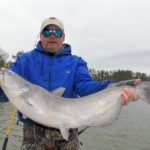
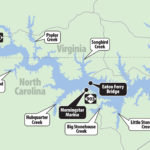
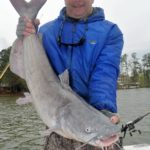
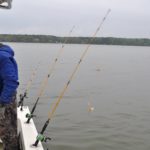




Be the first to comment